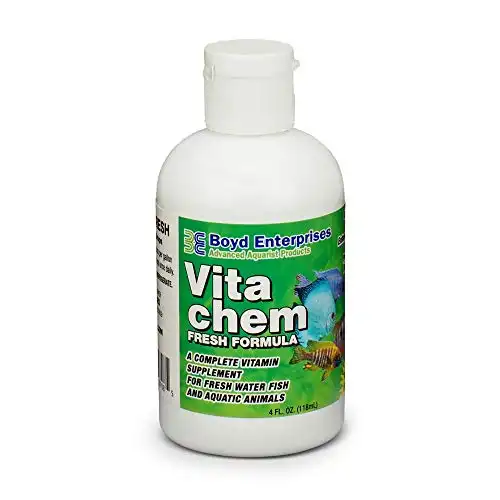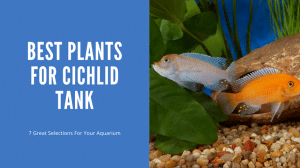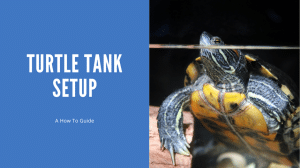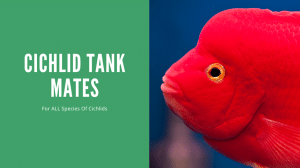Thank you for visiting! By the way… any links on this page that lead to products on Amazon and other stores/partners are affiliate links Aquarium Store Depot earns a commission if you make a purchase.
The Discus Fish. To many who are fans of this fish, they are often called the Kings of the Aquarium. The are large, striking, and very beautiful freshwater fish. They are also to many considered a very difficult fish to keep. It is our dream fish and the one we wish we could have, but intimated by what others have said about proper Discus Fish Care.
Today’s blog post is all about Discus Fish Care. My goal here is to really break down Discus Fish care into critical key concepts. If these concepts are followed, you will have much better success than the average Aquarium Discus Fish keeper. I want to make you well informed and armed with the knowledge to become successful and happy with your Discus Aquarium.
Key Takeaways
- Discus fish have very specific requirements compared to most tropical fish – with temperature and pH being the biggest standout
- They are very peaceful fish that can be easily bullied
- They require longer aquariums and high-quality diets
- Example tankmates include neon tetras and cory catfish
- Clean water is a must for them. Frequent water changes and high-end filters are a must!
A Quick Overview
| Scientific Name | Symphysodon discus |
| Common Names | Discus Fish, Discus, Pompadour fish |
| Family | Cichlidae |
| Origin | South America, Amazon river |
| Diet | Omnivore |
| Care Level | Advanced |
| Activity | Slow to Moderate |
| Lifespan | 10-15 years |
| Temperament | Peaceful |
| Tank Level | Middle |
| Minimum Tank Size | 75 gallon |
| Temperature Range | 82°-89°F (28°-32°C) |
| Water Hardness | 1 to 4 dKH |
| pH Range | 6.0 – 6.5 (for most varieties) |
| Filtration/Water Flow | Low |
| Water Type | Freshwater |
| Breeding | Egg-layer |
| Difficulty to Breed | Moderately difficult |
| Compatibility | Limited, Best as a species-only tank |
| OK, for Planted Tanks? | Yes, but requires low nutrient water |
History
Discus fish originate from the Amazon River. There original homes were around submerged tree roots and branches. This water was very clean and calm. The Discus Fish is a member of the cichlidae family. The cichlidae family is the largest group of freshwater fishes. However, Discus do not share the characteristics of many other Cichlids. Discus are very peaceful by nature while many Cichlids are aggressive and built for speed.

The first Discus was identified in the early 1800s by Johann Natterer1. Natterer was instrumental in the identification of many animal species in the Amazon. His name is associated with several animals such as the Natterer’s bat.
The fish Discus to be imported happened around 1921. The shipping handling method for these fish at the time where not very good. Many died during the shipping process due to stress. It wasn’t until the mid 1930s that Discus started getting bred in captivity. These happened when the first Discus Fish were imported to the United States and Dwight Winter became the first person to successfully breed Discus in capacity.
As breeding techniques advanced and shipping improved, we started to see more varieties of Discus. Between the 1970s and 80s Discuss breeders started to create more colorful and vibrant varieties of Discus, like the Powder Blue Discus shown below.
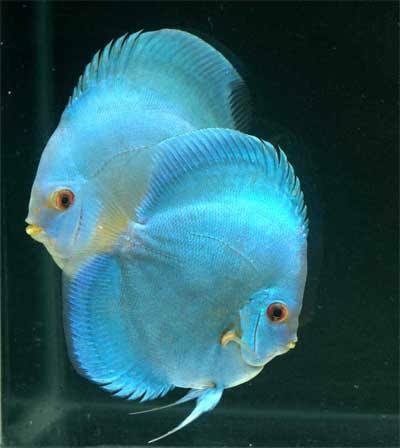
Discus Fish Care – The Keys To Success Keeping Discus
Discus to many are considered very challenging to keep (video from our YouTube Channel). They are more difficult to keep then the average freshwater tropical fish, but not impossible. It is a matter of getting all the care elements dialed in so you have a stable tank. Discus Fish require a high investment. They need bigger tanks and higher quality equipment to provide the best environment for them. Let’s break down the keys to success for Discus Fish. They are:
- Housing
- Filtration
- Source Water
- Temperature
- Oxygen
- Decor
- Substrate (Or no substrate)
- Diet
- Tank Mates
Tank Size (Housing)
Adult Discus are large fish. They can grow up to 6 to 8 inches long, they also grow height wise as well due to their dish shape. Like most Cichlids, they are territorial to their own kind, so they need space to thrive and and a natural looking environment to curb their aggression.

The best tank to start a Discus Tank with would be a 75 gallon aquarium. Some people say a 55 gallon aquarium is okay, but I prefer the 75 gallon because it is both wider and taller. These are both factors we want to keep in mind when it comes to the taller disc shapes of these fish.
For a 75 gallon aquarium, we are looking to house 6 adult sized discus fish. Some people will start these tanks up with 10-12 younger discus and allow them to grow. Eventually, they will reduce their numbers to 6, with two being males. Reducing the male population reduces the aggressiveness. A 75 gallon aquarium is not an aquarium you can easily order online.
My suggestion would be to either purchase the aquarium from a petstore when they go on sale or attempt to purchase a cheap used tank from a hobbyist or classified ad. Marineland is a good brand to purchase a first time Discus Aquarium. They are well built and have black silicone instead of clear.
Tank Filtration
DIscus require very clean water. Their natural environment has clean water and the average home aquarium does not provide the quality water or filtration they need. Many hardcore discus keepers will sort this out with daily or every other day water changes. These water changes are very large – usually 50% or more. We can do the same thing here, but if you to build a foundation of proper equipment that can help keep your levels down you won’t be a slave to water changes.
Our first option is a Power Filter like a Hagen Aquaclear. The aquaclear always makes it into our fish tanks if one is looking for a hang on the back filter. It will do a great job for you and will work trouble free for years.
Our next option is a premium piece of equipment like a Canister Filter. Again, our focus on Discus tanks is very clean water. A Canister filter is ideal for this as we can stuff these with premium level biomedia like Biohome Ultimate Filter Media. This media is one of the best out there in the market and has the ability to reduce nitrates in the aquarium. We are going to pair this media inside the best canister filter on the market today, the OASE Biomaster Thermo. This canister filter comes with a heater bay to place your heater and with a ton of media space.
The Pro's Choice
The top choice among professional aquascapers. German engineering and equipped with an intregrated heater.
This is a premium option, but let’s keep in mind that Discus are a premium level fish. These fish are not cheap and they demand proper equipment and maintenance. Let’s set ourselves up for success by getting high end equipment.
Source Water
Discus Fish need very clean water. I will say this over and over again in this blog post to drive in the point. It is one of the most critical factors to your success. Sometimes, the source water of your tap water is not going to be good enough for your Discus Fish.
It’s going to depend on your city’s water report. I would suggest you get a city water report and get the readings of levels in your tank to determine if an RODI Unit is going to be needed. The main thing we are going to need to look for are high nitrates. If you have high nitrates coming out of your tap water, you may need to consider an RODI Unit or RO Unit. RO water becomes a major purchase when it comes to breeding or raising Discus fry.
Budget Option
Compact and great for smaller tanks. This is the best unit if you live in an apartment or dorm
The RODI unit shown above is an example of a good unit that will get the job done. If you are going to use RO or RODI water, you will want to use a trace element supplement. Seachem’s Discus Trace is just the supplement to use. Distilled water can also work in a pinch, but given the tank size needed for these fish, it’s usually not a good long term choice.
For those of us using tap water, it is very important to age your tap water for 24 hours then treat it with a declorinator like Seachem Prime. You can further prep with a heater and airstone or submersible pump. The preference is aged tap water + prime if your source water is good enough.
I know not everyone’s tap water is going to be adequate. If you cannot obtain your city’s water report, I would suggest getting an RO unit. Nearly all units designed for aquariums will be an RODI unit. For Discus, you can remove the DI stage to save on the resin as long as your TDS output is within 50-100.
Temperature
Next to clean water, temperature is the second big factor to Discus Fish care success. Discuss thrive on temperatures from 85 to 86 degrees. That is a lot warmer than most tropical fish that likes 78 degrees. What will usually happen with Discus under lower temperatures is that they will not fare well under typical tropical fish temperatures.
We want higher temperatures for a Discus fish for multiple reasons. Warmer water keeps our Discus active. It increases their metabolism and tends to produce a more colorful fish. Many Discus are also keep at higher temperatures.
Imported Discus from Germany and Malaysia will often keep their temperatures higher. You will also want to see what temperatures the Discus you are looking to buy are kept at as you may need to accumulate. The main issue you will deal with higher temperatures is bacterial infections. If you have an outbreak, they are tougher to deal with at higher temperatures because the bacteria will produce faster.
We want to use the Best Aquarium Heater we can get our hands on. For a Discus aquarium, the Eheim Jager heaters are the best heaters to go with. It would also be wise to get an aquarium heater controller like an Ink Bird to ensure you have temperatures that are accurate and fail proof.
Tank Aeration
With higher temperatures and larger fish we will be dealing with oxygen issues in our aquarium. Also, Discus Fish prefer calm waters so we cannot use a Wave Maker for our setup. We are going to want to use a proper Aquarium Air Pump to provide a high amount of oxygen to our Discus tank.
A great air pump option for larger tanks. The AP series is Tetra's best product among all its offerings
Since we are dealing with larger tanks with Discus, a powerful air pump is in order. The Tetra Whisper AP series is the ideal aquarium air pump for Discus tanks. It is powerful and can handle the needs of these large fish while not making you lose your mind with their noise.
Tank Decorations
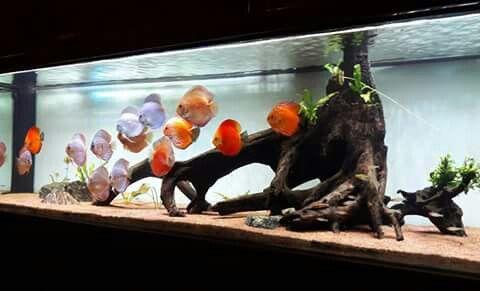
From what we know about the history of Discus Fish, they lived near submerged tree roots and branches. The best decor for Discus is going to be Driftwood. However, we need to be very careful in our handling and selection of driftwood. We want a wood that will not alter the pH of our tank and we want something that is not going to rot away and leech nutrients all over the place.
Editor's Choice
Manzanita offers it all. Great shape, low tannins, quick to water log and reasonably priced. It's the ultimate driftwood!
Manzanita wood is probably the best wood to use for a Discus tank. It is clean and looks the part for their natural environment. Sandblasted Manzanita is what we want to look for. There are large showpieces you can purchase from the link above. These large sizes will show better in a large Discus tank.
Prepping the wood for the aquarium is a major process we must undergo for our Discus. Prepping driftwood for aquarium usage requires us to boil it for 10 to 15 minutes. This is to clean the rock of decaying, dead material and to remove tannins. Tannins being released from driftwood will dark the water of your aquarium giving it a tea-colored look. Below is a video by Long Island Fish Guy showing the process.
The main challenge with boiling a large piece of driftwood is you cannot fit it in a pot. To work through this there are two approaches. One is to boil in parts that you can dip into a cooking pot. Another is to put the wood in a bathtub or outside and pour the boiling water on the wood. Be very careful if you have to do this as you can hurt yourself.
Tank Substrate
Discus keepers fall into two camps. Those who want to do a bare bottom tank and those who want the look of a natural substrate. There are pros and cons to both.
For a bare bottom tank, we are working to create a very clean tank. The bare bottom approach is the preferred approach for breeders and those raising Discus fry. You can do a bare bottom tank for adult discus. For many, they will feel that the look of a bare bottom is odd. Painting the bottom of the aquarium white will help with the look. Other hobbyists have used aquarium safe tile to decorate their bottoms.
A discus tank with a natural substrate will provide a natural aesthic look. The problem you run into with a substrate is waste accumulation and dealing with potential nutrient issues. The best way to work with a substrate is to use it for aesthic purposes only.
We aren’t going to make an active substrate and we want a thin substrate similar to what I suggested with my prior Goldfish Tank post. We want no more than a half inch for our substrate. This will limit our ability for using rooted Aquarium Plants, but we will see later on that rooted plants are not the best for Discus Tanks.
The easiest substrate to maintain for a Discus tank is sand. We also have to consider the colors of our Discus. Discus fish are bright in color so a dark color would make them look darker. A lighter substrate will make our Discus look more bright. Light substrate is what we are going to want.
This sand by Caribsea is perfect for supporting the foraging habit of goldfish. Also works with bottom feeders and discus fish.
A sandy grain size substrate like the one pictured above from Caribsea is what we are looking for. Again, we only want a half inch of substrate. This substrate is also pH neutral – something we will desire as most Discus for keeping purposes will need acidic water to neutral. This range of pH is 6.8 – 7.6 for most Discus varieties. If we are breeding discus, pH needs can be different. But, the best practice for breeding Discus is bare bottom.
Diet
Discus are big and colorful fish. They are demanding when it comes to diet as they need a varied and balance diet in order to keep their immune systems and colors healthy. Discus also require to be feed multiple times a day. They also have small mouths for their size and are slow eaters.
When it comes to food, the smaller is better. We want a mix of bloodworms, blackworms, and vibra bites. The delivery method is important as well. I have mentioned in past posts the amazing nutritional value of blackworms in the past. Blackworms would be my go to here. Freeze Dried Blackworms with a vitamin boost like Vita-Chem is a great mix.
One of the best nutritional supplements you can use for freshwater fish. Works great with pellet and fried dried foods.
For pellet food, Vibra bites is perfect for discus. It has the worm like shape that get your Discus going.
A color enhancing formula that has a worm shape. Excellent for discus fish.
For feeding worm food like black worms a feeding cone can useful for keeping the food in place. Discus are slow eaters so this keeps the food in one place so your Discus can eat while keeping your tank clean. The video below by Canadian Aqua Farm shows a feeding cone in action.
Tank Mates
Finding tank mates for a Discus Fish tank can be quite the challenge. Because we are going to keep our Discus in hotter waters, this is going to hard on many tropical fish. Also Discus are slow feeders so an aggressive feeder is going to out compete and stress our Discus.
Aquarium fish like barbs are going to be bad tank mates due to how aggressive and active they are. Angelfish and Rams should also be avoided. We will also want to be careful about adding too many schooling fish like tetras who as a group can out compete our discus for food.
When we think about good tank mates, Cardinal Tetras and Corys come to mind. It is doable, but my recommendation is to make your Discus the centerpiece of your aquarium. Start with a dominant Discus Tank first then consider adding tank mates if you really want to.
Live Plants for Them

A planted tank with Discuss is one of the most challenging setups you can attempt in the freshwater hobby. You are working against multiple factors when trying to add plants with Discus.
The first is the temperature. Because Discus do better in warm weathers, many plants will struggle to thrive at 85-86 degrees. The second factor working against is the lack of nutrients. Remember when I said that Discus Fish like clean water? Clean water means low nutrients. Low nutrients means that plants are going to have a hard time getting the food they need and we cannot use an active substrate.
Active substrate like the ADA Aquasoil I recommend in our Best Planted Tank Substrate post will cause higher nutrient levels in the tank. Great for rooted and carpeting plants, but bad for Discus.
So what does this leave us with? We just eliminated a number of possible aquarium plants from the list. We are going to want live plants that can not only tolerate the higher temperatures of our Discus tank, but also will still grow in a low nutrient environment. We also want plants that can tolerate a non CO2 injected environment as we want to ensure we have a rich amount of oxygen available with our higher temperatures.
This leaves us with the hardiest of live plants, preferably ones that are column feeders versus root feeders. These will will do well without CO2 These plants are:
- Anubis
- Java Fern
- Shallow Rooted plants like
- Bacopa Caroliniana
- Micro Swords
- Vallisneria
All of the plants above are considered Low Light Aquarium Plants. All you need to do to if you want live plants is to upgrade your lights to a proper Planted Tank LED System. I would recommend Current USA’s Serence Pro lights.
Current USA's offering into aquascaping is an incredible value. Spectrum, spread, easy to program and great PAR output.
When planning a planted Discus Tank, we will need to keep in mind spacing. We will want our plants either attached to our driftwood or in the background of our aquarium. We want to keep the rest of the aquarium open for our Discus to swim and not feel crapped.
We want to avoid densely planted tanks. Lastly, our fish population decreases in a planted setup. For a 100 gallon fish tank, we would drop down to 5 to 6 Adult Discus. We do this because our substrate become an issue with waste with a planted tank. We want to keep our tanks very clean for Discus, so our best approach here is to reduce our aquarium fish population.
Another thing to keep in mind is that Planted tanks are not good for raising fry or breeding. If you are looking to breed, the best practice are bare bottom tanks.
Different Types
There are tons of breeds of Discus. They are all long-lived, get large, and can be breed under the right conditions. We have two types of Discus in our hobby:
- Wild Discus
- Domestic Discus
Wild

The wild discus are the original Discus where our domestics come from. The Blue Green wild discus is where most of our Domestic Discus come from.
The Heckel Discus is one of the most sought after wild Discus. They are found in the Rio Negro. They are one of the most demanding Discus to keep in the aquarium due to their pH requirements. They prefer a pH closer to 4.0, which is a challenge for many aquarium keepers.
All wild Discus are imported and difficult to keep in comparison to domestically bred Discus who are used to aquarium environments. Wild caught Discus are best kept to the experts and Discus enthusiast.
Domestic (Captive Bred)
There are more than 1000 types of Discus Fish available in the market, day by day count is increasing because of cross breeding and demand on market. And this video below shows the diversity of Discus fish. One thing to keep in mind is that Discus with a yellow coloring have difficulty maintaining their color.
I’ll go over the various discuss types in another post to keep this one short. Check out the visual below by Knock Out Aquatics to see how varied Discus get!
How To Select Them
Discus are very sensitive fish. They require careful selection when choosing a quality store to purchase from an a healthy specimen. Here are a few things to look for:
- Round shape – look for deformities
- Clear eyes – no nicks or cloudy eyes
- Good color – poor color indicates stress or poor diet
- Fins – Look for straight fins. Watch out for bent or clamped fins
- Body mass – Your Discus should look thick. Do not purchase a thin Discus
- Good appetite – Your Discus should actively eat when fed
- Swimming activity – The Discus should be swimming in the open not in a corner
How To Quarantine Them
While I believe you should quarantine all fish, I know most people will not. Discus fish are a premium fish and require quarantine into to thrive. The quarantine process generally takes 8 weeks and involves frequent water changes – as often as every day!
In the second week, Discus experts would recommend prophylatic treatment with Prazipro or Levamisole to treat for internal parasites. Internal parasites are very common with Discus and is a mild treatment2.
You would stop treatment in the 6th weeks and do a 2 week observation period. You should not use antibiotics or external parasite treatments unless you see signs of disease. To learn more about diseases check out this fish disease article. Some commmon factors that cause health issues would be:
- Chemical poisoning – from poor water conditions
- Dissolved gases – from low oxygen or high CO2 levels
- Poor tank hygiene
- Nutritional deficiencies
- Gill flukes, parasites — which is why we quarantine!
- Bacterial infections
Your quarantine tank should be bare bottom with a cycled filter. It should be away from your display and you should use a separate net for it. Given the time involved of quarantine, do not plan on traveling or vacationing during this time. Know your schedule and plan ahead!
Breeding
This could be a separate post in itself, so I’ll keep it brief. There are two methods for breeding Discus fish – artificial and natural.
Artifical Breeding
This involved removing the eggs after they have been fertilized. Fry are hatched and fed slime when they are initially born. As they grow, they are transitioned to baby brine shrimp and commercial foods. This is a common method of breeding for commercial Discus breeders. PVC is used as a surface to lay eggs and collect them. It is efficient and more profitable from a business perspective
Natural Breeding
Natural Discuss breeding allows for the eggs to be tended by the parents. The fry hatch and are free to swim in the aquarium. The fry will eat their parent’s slime coat when they are born. They eventually will be transitioned to baby shrimp and commercial food.
This is considered one of the most fulfilling experiences in our hobby. The parents take takes tending to their babies. They fish fry receive antibodies from their parent’s slime coats. As a result, they can develop a stronger immune system.
Where To Buy
Discus fish are one of the more difficult fish to purchase. You will want to purchase them from a high quality local fish store if you are looking to buy locally. If you do not have a good local fish store, you can purchase high quality specimens at tradeshows.
A more recent development has been the emergence of What You See Is What You Get (WYSIWYG) online fish stores. Most are small specialty fish stores. When looking at one, make sure they offer a arrive live guarantee and a warranty of at least 7 days.
Additional Resources (Books To Read)
There are many books out there that go beyond the scope of this blog post. However, not all are created equal. There are two books I recommend when it comes to Discus care.
Discus World
A great deep dive book on Discuss keeping for a beginner. Written by a discuss breeder
The Discus World book is a good casual dive into the world of Discus keeping and breeding. it is informational enough to get you beyond what I have covered here, yet friendly enough for a beginner to pick up.
The Discus Book
First published in 1989, this book is an update with a full color edition. Written by Alastair Agutter, who has been an authority on aquariums since 1967
The Discus Book is the book to purchase if you want a comprehensive guide on Discus. This book is written by Alastair Agutter. Alastair has been involved in the aquarium hobby since 1967. He is a veteran in the industry. He offers a no sales approach to proper care. It’s a refreshing perspective to read as our aquarium hobby evolves into a gadget first approach. He’s all about the biological and science. It’s a must read if you want to get serious about Discus!
Closing Thoughts
Discus fish are the known as the king of the aquarium. They are beautiful but difficult to keep. If you are up to the challenge, they can be one of the most rewarding experiences in our hobby. I hope I showed you what Discus fish can offer you as a pet by reading this post. If you have any questions, leave a comment below. Thank you for reading.
- About the Author
- Latest Posts
I’m thrilled that you found Aquarium Store Depot! Here you’ll find information on fish, aquariums, and all things aquatics related. I’m a hobbyist (being doing this since I was 11) and here to help other hobbyists thrive with their aquariums! I adhere to a high quality Editorial Process and Review products with real life field usage and practical analysis.







